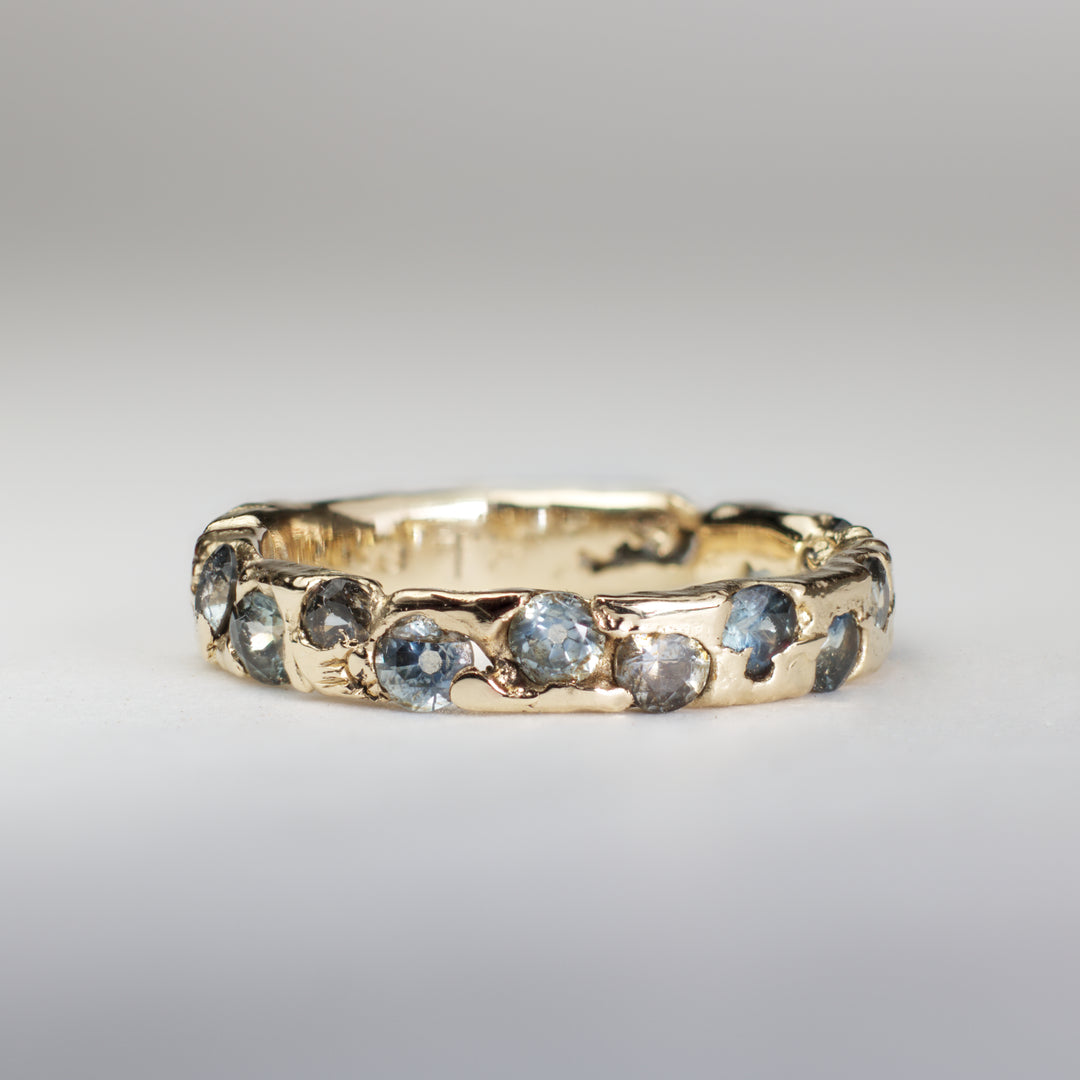What Is an Old Mine Cut Diamond?
Before modern machines formed diamonds into perfect shapes, diamonds were cut by hand, guided only by the cutter’s eye and the flicker of candlelight. Old Mine Cut diamonds are relics of that time: imperfect, romantic, and full of soul.
At Rigby Leigh, we choose to use Old Mine Cut diamonds not just for their antique charm, but because they align with everything we care about, like craftsmanship, ethics, and story. These stones are the perfect complement to our hand-cut Montana sapphires and gold settings cast in wood.
Here’s why we love them, and why you might, too.
What Is an Old Mine Cut Diamond?
Old Mine Cut diamonds are a type of antique diamond cut that was popular from the early 1700s through the late 1800s, particularly during the Georgian and Victorian eras. They’re considered the precursor to the modern brilliant cut, but don’t expect factory symmetry. These stones were designed to catch candlelight, not fluorescents, which gives them a softer, warmer glow.
What Makes an Old Mine Cut Diamond Unique?
Each Old Mine Cut diamond was shaped entirely by hand, which gives them a distinctive, deeply human quality. Here’s are some common features to look for and how to spot an old mine cut:
-
Cushion shape. Square with rounded corners, often slightly irregular. No two are identical.
-
58 facets. Similar to a modern brilliant cut, but arranged to create a “chunkier” sparkle.
-
Visible culet. A large bottom facet (culet) that you can usually spot right through the top of the stone.
-
Small table and high crown. The small top facet and tall, domed shape give these stones serious personality.
-
Natural asymmetry. Because they were cut by eye, you can expect quirks and lots of charm.

Why People Still Love Old Mine Cut Diamonds
Despite their age, Old Mine Cut diamonds have never felt more relevant. Their charm lies not just in how they look, but in what they represent.
They Glow Differently
These diamonds were cut long before electric lighting existed and were crafted instead to shine in the gentle flicker of candlelight. That’s why they give off a softer, warmer glow than modern cuts, which are designed to sparkle under bright showroom lights. If you’re drawn to subtle shimmer over dazzling brilliance, an Old Mine Cut will speak your language.
They’re One-of-a-Kind
No two Old Mine Cut diamonds are ever the same. Since they were shaped entirely by hand, each one has its own proportions, quirks, and personality. Some have slightly tilted facets, some have off-center culets, and all of them are completely unique. In a world full of mass production, they offer a rare individuality.
They’re Ethically Sourced by Nature
Because Old Mine Cuts are antiques, they’ve already been mined, often more than a century ago. Choosing one means you’re not contributing to modern diamond mining, which can have serious environmental and human rights consequences. It’s a more sustainable, low-impact way to wear a diamond with integrity.
They’re Surprisingly Affordable
Modern diamonds are priced according to strict grading systems that emphasize symmetry, clarity, and brilliance. Old Mine Cut diamonds don’t always “score” high on those metrics, but that’s exactly why they’re so special. And often, it means you can find a larger or more interesting antique stone for less than the cost of a modern equivalent. Basically, you’re paying for character, not perfection.
They Tell a Story
Wearing an Old Mine Cut diamond means carrying a little piece of history with you, something that was worn and loved long before you. Whether it was once part of a Victorian brooch or a Georgian engagement ring, these stones have lived lifetimes before yours, and that sense of continuity, of meaning passed down through generations, is part of what makes them so powerful today.

How Old Are Old Mine Cut Diamonds?
Most Old Mine Cut diamonds were crafted between the early 1700s and late 1800s, spanning:
-
Georgian Era (1714–1830)
-
Victorian Era (1837–1901)
Some transitional cuts lead into what’s known as the Old European Cut, which is a slightly more modern antique style with a rounder shape and more symmetry.
Are Old Mine Cut Diamonds Valuable?
Yes, old mine cut diamonds are valuable, but in ways that go beyond the 4Cs. Their value depends on typical factors like carat weight, clarity, and provenance, but because Old Mine Cuts don’t fit modern grading systems, they’re often priced lower than their contemporary counterparts, at least for now.
As more people look for jewelry with story, character, and sustainability, these antique diamonds are becoming increasingly collectible.

Why Rigby Leigh Uses Old Mine Cut Diamonds
At Rigby Leigh, we believe jewelry should feel personal, grounded, and alive, and that’s why we work with Old Mine Cut diamonds. They align with our values because the stones were mined and cut over 200 years ago, so there’s no new environmental toll or modern exploitation. We also love that they feel human and that they’re not perfect. Their slightly wonky proportions pair beautifully with our gold settings cast in carved oak molds, and it’s all part of a slower, more thoughtful process.
Old Mine Cut vs. Other Antique Cuts
Old Mine Cut vs. Old European Cut
-
Old Mine Cut: Cushion-shaped, more irregular, earlier
-
Old European Cut: Rounder, more symmetrical, later (late 1800s–early 1900s)
Old Cuts vs. Modern Cuts
-
Old cuts: Soulful, handmade, full of character
-
Modern cuts: Precision-focused, lab-graded, designed for maximum brilliance

Hand-cut by candlelight and worn by generations before us, old mine cut diamonds carry a deep sense of character and care.
At Rigby Leigh, we believe the future of jewelry is rooted in the past, so we build every ring around these storied diamonds, pairing them with Montana sapphires and gold cast in wood. That way, no two pieces are ever the same, just like the people who wear them.
Shop our antique Old Mine Cut diamond jewelry, imperfectly perfect, naturally different, and always personal.





